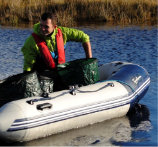Ecology underpinning conservation management of rare freshwater fish
Researcher(s): Oliver Hooker
Supervisor(s): Colin Adams
Department: Institute of Biodiversity, Animal Health and Comparative Medicine, MVLS
Institution: University of Glasgow
Brief Description: At present my research is in the area of ecologically driven evolution in freshwater fishes and how this may complicate conservation planning for species that show high levels of phenotypic variation and divergence. To date my work has consisted of comparing phenotypically different populations of Arctic charr, Salvelinus alpinus, from Scotland and Ireland to identify ecological drivers that may affect morphological development. In addition to this I am currently running some laboratory based experiments exploring potential effects of climate change and global warming during early development. The effect of increased temperature during ontogeny, specifically looking at allometric scaling of the head, will be examined in Arctic charr. In addition I am conducting another experiment to establish the physiological effects of forced diet specialisation in powan, Coregonus laveratus and Arctic charr. This is linked to global warming which is anticipated to affect the timing of emergence in aquatic invertebrate and thus prey type availability for icthyofauna.
Funding Source(s): INTERREG IV
Project Status: Current
Start Date: 01/06/2012
End Date: 31/05/2015
Outputs: Improved insight and understanding of ecological factors important in developing conservation strategies in species of freshwater fishes that are highly plastic in their phenotype.
Oliver Hooker's Research Profile Page
Phenotypic variation; Mature male Arctic charr from Lough Finn (left) and Lough Fad (right), County Donegal, Ireland. These images show the high diversity in phenotype found within this specie.
Climate change experiment; Arctic charr eggs are exposed during late embryonic stages and early juvenile stages to high and low temperatures. Their morphology, bone development and metabolic rates will be compared to assess potential effects of climate.

